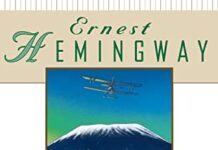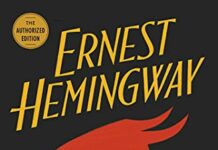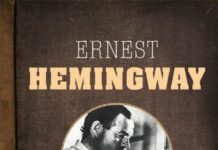
Ebook Info
- Published:
- Number of pages:
- Format: EPUB
- File Size: 0.91 MB
- Authors: Ernest Hemingway
Description
A later, posthumously published classic following the adventures of a painter in the midst of World War II.First published in 1970, nine years after Hemingway’s death, this is the story of an artist and adventurer—a man much like Hemingway himself. Beginning in the 1930s, Islands in the Stream follows the fortunes of Thomas Hudson, from his experiences as a painter on the Gulf Stream island of Bimini through his antisubmarine activities off the coast of Cuba during World War II. Hemingway is at his mature best in this beguiling tale.
User’s Reviews
Reviews from Amazon users which were colected at the time this book was published on the website:
⭐Good book, poor binding
⭐Beware posthumous novels. There’s an old adage I just invented. Not because I didn’t like “Islands in the Stream” but because sometimes they are not published in the author’s lifetime for a reason. In this case, it was probably because Hemingway decided to turn one act of “Islands in the Stream” into a novella called “The Old Man and the Sea,” which went on to become one of best-respected fictional works in the English language, winning both the Pulizter and Nobel Prizes. But I’m getting ahead of myself here.”Islands” is a three-act novel about a famous painter named Thomas Hudson, who lives in Bimini in the 1930s. Hudson has sophomoric, typically Hemingway-esque adventures with his rough-and-tumble expat pals when not at the canvas, but lives for the summers he gets to spend with his three children. This first act centers largely around a fishing expedition he takes with his kids, and one can see why he never published it, since it clearly inspired him to write “The Old Man and the Sea” and in any case was very similar in tone and feeling to parts of “To Have and Have Not.” In the second act it is now the 1940s and the middle of WW2, and Hudson lives in Cuba, drinking heavily to cope with personal tragedy and spending all of his free time at bars and whorehouses with various colorful characters you will readily recognize if you’ve ever read Hemingway before. We discover that when he is not drinking or fornicating he patrols the sea lanes off Cuba, looking for U-boats at the behest of the U.S. government. The final act, immediately following the second, is a long chase sequence, similar in some ways to the fishing sequence, except that Hudson is relentlessly hunting the survivors of a sunken U-boat who are trying to get to a friendly port in a stolen skiff.In some ways, “Islands” is more readable than most of Hemingway’s novels, for the simple reason that, divided into three distinct acts, it is more like three short novellas (or very long short stories) than an actual book, and I have always found Hemingway far more digestible as a short story writer than a novelist. All of his strengths are manifested in these acts: his subversive sense of humor, his punchy yet profound observations about life, his terrifying and sometimes disgusting emotional honesty, and the simple beauty with which he describes nature and man’s interaction with it. On the other hand, the book is also a showcase of his weaknesses. Hemingway’s characters are all the same – emotionally blunted, psychologically shallow, sophomoric in their habits, hard-drinking, and sexually amoral. In short, they are often easy to despise and nearly impossible to root for. His dialogue is all the same too, varying between that punchy, highly realistic style that rightly made him famous, and the relentlessly trivial, relentlessly facetious, rigidly stylized patter that ruined some of his better works. Most writers who sit down to compose a novel have an overriding desire to tell a story or say something about life, but if you’ve read one Hemingway novel, you already know what story you’re going to be told and how he feels about life, so reading the others is largely an exercise in curiosity or admiration — curiosity about HOW he will tell the same essential story (the hero destroyed but not necessarily defeated), and an admiration for the technique he uses to tell it. I admit to having this curiosity and this admiration, though I am frequently exasperated by the unvarying sameness of his characters and the brutal life lessons they endure with such inner turmoil and such outward indifference. This is by no means his finest book, but the first and third acts, though overly familiar if you’ve read his other works, are full of all the things that made Hemingway great when he was great.
⭐Those who read this book deserve to know that it’s not a finished work. It was published posthumously from Hemingway’s manuscripts, meaning it’s not in the form he would have chosen and doesn’t have the credibility as a Hemingway work that the novels published during his lifetime did. None of us can say what Hemingway would have kept or eventually cut from this work before he let it go to publication. Indeed, any careful reading reveals all sorts of passages or ideas he obviously lifted and used in A Moveable Feast. The fact that they remain here only shows that he hadn’t yet gotten back to turning this manuscript into a finished form.That said, this is a wonderful book and I feel great fondness for it. Yes, it’s uneven as a novel, but that is to be expected in an unfinished work that the author has not had a chance to edit. More importantly, for me, is it offers some writing that is simply among Hemingway’s best. The first few pages are practically an object lesson on how to drag readers into your fictional world. (Note to teachers of creative writing.) Over and over in the book are examples of how Hemingway learned about how to use concrete images from his friend the poet Ezra Pound, from the “needles” of the water in his shower, to the case of Coca-Cola he obtains for his boys’ visit, to his gin and tonic at the bar “opening the pores” of his stomach. TS Eliot’s objective correlative (which he also learned from Pound) on display in a novel.Does it work as a novel? No. The story is uneven. The fundamental concept is the story of a man with three sons who loses all of them, and how he copes. Personally, it doesn’t work for me. As a father I believe his experience would have been more traumatic than could be coped with by the old Hemingway stoicism. But again, this isn’t a finished work. Hemingway didn’t have a chance to go back and make the plot work. So the book can’t be judged on that basis, I don’t believe.All it can be judged on is the quality of the writing. And I think a person wishing to learn how to write English prose can do a lot worse than study this book. There are wonderful things here from a writer’s perspective. And on how it makes you feel about the protagonist. Even when he’s thinking or feeling or acting in a way that I think totally unrealistic, I still believe Tom Hudson is totally real. THAT is why Hemingway was so good.
⭐Islands in the Stream was published in 1970, 9 years after Ernest Hemingway’s death. Mary Hemingway and the publisher edited and prepared the original manuscript for publication.The Stream of the title is the Gulf Stream and the story, a long narrative of some 450 pages, follows one Thomas Hudson, a painter, game fisherman, drinker and adventurer. If we change “painter” to “writer” there is no doubt who Hudson is based on.The book is in three parts. The first part is called “Bimini”, one of the Gulf Stream Islands. It focuses mainly on Thomas Hudson’s relationship with his two sons and his estranged wife. It includes a truly epic, 28 page account of one son’s battle with a swordfish; absolutely magnificent stuff.For me, Part 1 of the book, “Bimini”, taken on its own, is perfection. It is the best Hemingway that I have ever read and is way up there on my personal best of all time and all comers. High praise, and not casually given. It is a perfect, complete book in its own right, and I would award it 100 out of 100.What follows, Parts 2 and 3, the next 250 pages, is not bad. But the only thread of continuity from Part 1 is Thomas Hudson himself. There seems little other logical reason for it to be there. It doesn’t extend the story of Part 1, and it certainly diminishes its impact. Had I been his editor, I would have voted to publish “Bimini” on its own. I wonder would Hemingway have done this had he lived?This is well worth buying for Part 1 alone, even if you never read Parts 2 and 3. It is sublime writing, and deeply moving. Hemingway can make your blood race, your heart thump, your hairs stand on end; but he can also make you weep.
⭐I would give this four and a half stars if I could but I cannot, so five it is.The overriding theme is about loss, of people and personal relationships, and the resultant unhappiness, bitterness and regret.The setting is sailing and fishing, two things which do not really interest me but, because of the quality of the writing, drew me in and presented a compelling and engrossing read.The clear consensus is that this is not Hemingway at his best but, even when he is off the boil, he is better than most, especially his descriptive writing.
⭐Very well written but long and wanders a little in places. First and third parts are tauter and more engaging than the second (Cuba). I did not expect what turned out to be chronicles of sections of Thomas Hudson’s life rather than a narrative with a discernible plot, though, in the last part, the pursuit of the crew of the submarine which had been sunk off Cuba did have a more coherent thread. The work of a superb writer but a little disappointing as a result.
⭐Hemingway is master of dialogue to push a story on and this is interspersed with dramatic action which is breathtaking. If this was all then it might be an action packed thriller, but it isn’t. It’s part of a rich vein of experience lived by Thomas Hudson and we live it with him as the scene shifts and shifts again.You mighty have gathered that I do enjoy Hemingway. I read this first at university and now fifty years later it is as, if not more, intense.
⭐Despite parts that weren’t so very interesting to me (a long fishing trek, the search during war) the writing is such that I felt so drawn to it. And just as you think that maybe Hemingway isn’t THAT good – wham! he slams it to you! My favourite part was when Thomas Hudson is talking about his sons and their various characteristics – such love he shows! He has a way. And it is a great way.
Keywords
Free Download Islands in the Stream: A Novel in EPUB format
Islands in the Stream: A Novel EPUB Free Download
Download Islands in the Stream: A Novel EPUB Free
Islands in the Stream: A Novel EPUB Free Download
Download Islands in the Stream: A Novel EPUB
Free Download Ebook Islands in the Stream: A Novel





